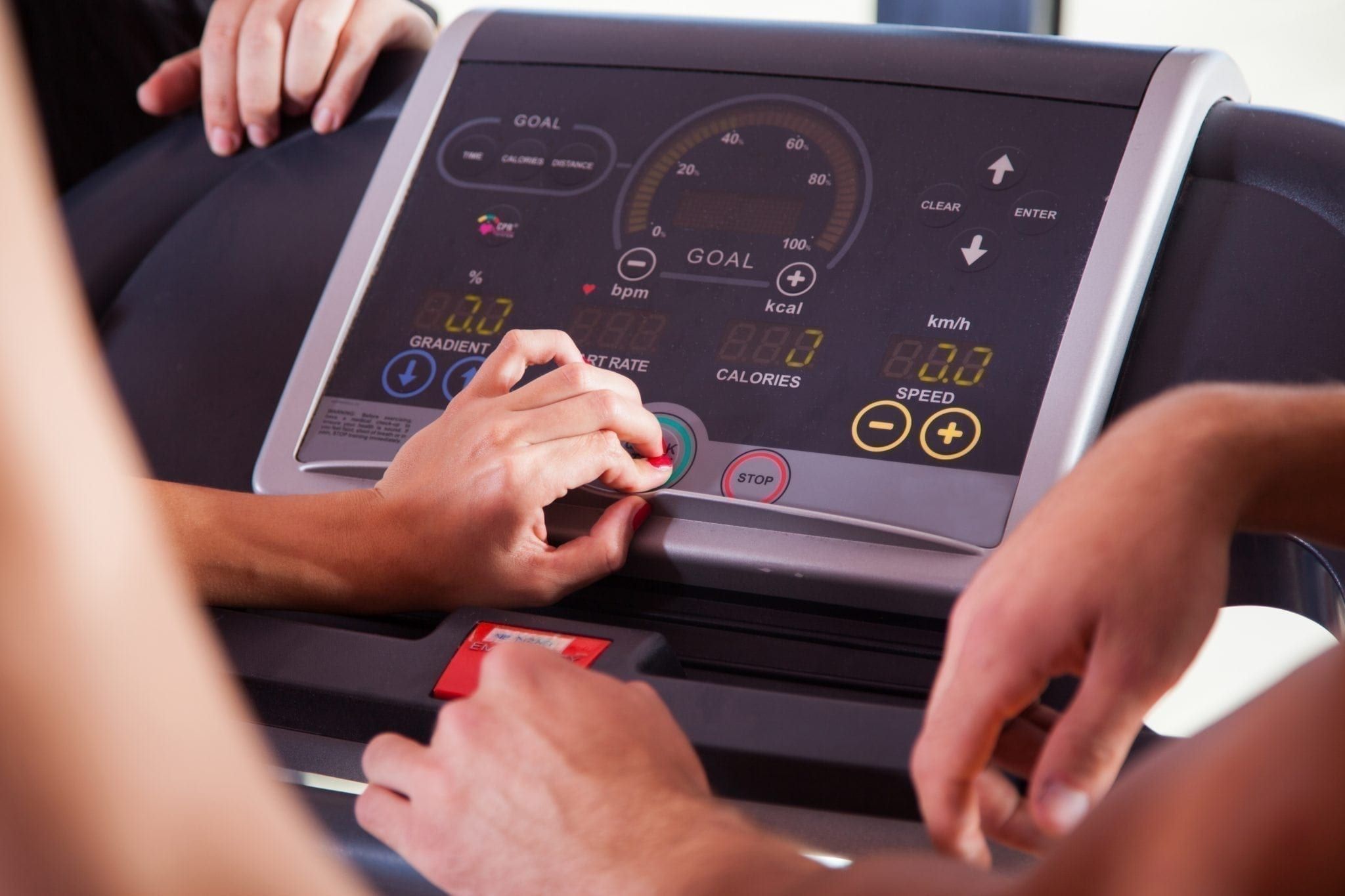Home>Misc>Featured>How To Calculate Calories Burned During Interval Training


Featured
How To Calculate Calories Burned During Interval Training
Modified: January 22, 2024
Learn how to calculate the calories burned during interval training with this comprehensive guide. Discover the benefits of this featured workout technique and start maximizing your calorie burn today.
Introduction
Interval training is an extremely effective form of exercise that can help you burn calories and improve your overall fitness. It involves alternating between periods of high-intensity exercise and short rest periods, challenging your cardiovascular system and boosting your metabolism. Whether you’re a beginner or a seasoned athlete, incorporating interval training into your fitness routine can yield impressive results.
Understanding how many calories you burn during interval training is essential for tracking your progress and achieving your fitness goals. While there are various methods for calculating calorie burn during exercise, it’s essential to select a reliable and accurate method to get the most precise estimate of calories burned.
In this article, we will explore the different factors that affect calorie burn during interval training and provide you with several methods for calculating this burn. Additionally, we’ll highlight the accuracy and limitations of these calculations and offer tips for maximizing the effectiveness of your interval training sessions.
By the end of this article, you’ll have a comprehensive understanding of how to calculate calories burned during interval training, enabling you to tailor your workouts and track your progress more effectively.
Understanding Interval Training
Interval training is a type of cardiovascular exercise that involves alternating between periods of high-intensity exercise and short rest or recovery periods. Unlike steady-state cardio exercises like jogging or cycling at a consistent pace, interval training pushes your body to work harder during the high-intensity intervals, resulting in a greater calorie burn and improved cardiovascular fitness.
The high-intensity intervals in interval training increase your heart rate and metabolism, causing your body to burn more calories both during and after the workout. This phenomenon is known as excess post-exercise oxygen consumption (EPOC), or the afterburn effect. During this period, your body continues to burn calories at an elevated rate to recover and restore itself to its pre-exercise state.
Interval training can take many forms, depending on your fitness level, preferences, and goals. Some popular interval training exercises include sprinting, circuit training, jump rope, and high-intensity interval training (HIIT) workouts. The duration and intensity of the high-intensity intervals can vary depending on your fitness level and the specific workout you’re doing.
The benefits of interval training go beyond calorie burn. It can also improve your cardiovascular endurance, increase your aerobic capacity, build lean muscle mass, and boost your metabolism in the long term. Additionally, interval training can be more time-efficient than traditional steady-state cardio, as you can achieve similar or even better results in less time.
It’s important to note that interval training is a demanding form of exercise and may not be suitable for everyone. If you have any underlying health conditions or are new to exercise, it’s advised to consult with a healthcare professional or a certified fitness trainer before starting interval training.
Now that we’ve covered the basics of interval training, let’s explore the factors that can affect the number of calories burned during your interval training sessions.
Factors Affecting Calories Burned in Interval Training
When it comes to calculating the number of calories burned during interval training, several factors come into play. Understanding these factors can help you estimate your calorie burn more accurately and make adjustments to your workouts as needed. Here are some key factors that can affect the number of calories burned during interval training:
1. Intensity: The intensity of your interval training plays a significant role in the number of calories you burn. The higher the intensity, the more calories you will burn during your workout. If you push yourself to your maximum effort during the high-intensity intervals, you can expect a higher calorie burn.
2. Duration: The length of your interval training session also influences calorie burn. A longer workout session usually leads to a higher total calorie expenditure. However, keep in mind that shorter, more intense workouts can still be very effective in terms of calorie burn and overall fitness benefits.
3. Rest Periods: The length of your rest or recovery periods between high-intensity intervals can impact your calorie burn. Shorter rest periods can increase the overall intensity of your workout and result in a higher calorie burn. Conversely, longer rest periods allow for more recovery and may lead to a slightly lower calorie burn.
4. Body Weight: Your body weight can influence the number of calories burned during interval training. Generally, individuals with higher body weight tend to burn more calories during exercise due to the increased effort required to move the body. However, it’s important to note that weight is just one factor among many, and other factors such as fitness level and metabolism also play a role.
5. Fitness Level: Your current fitness level can impact the number of calories burned during interval training. As you become more fit, your body becomes more efficient at exercising, and you may burn fewer calories for the same workout. This is why it’s important to continually challenge yourself by increasing the intensity or duration of your interval training sessions.
6. Exercise Variations: The specific exercise or activity you choose for your interval training can affect the calorie burn. Some exercises, such as running or jumping rope, typically result in higher calorie burn compared to other lower impact exercises. Experimenting with different exercises can help keep your workouts engaging and maximize your calorie burn.
By considering these factors, you can get a better estimate of your calorie burn during interval training. In the next section, we will explore different methods for calculating the number of calories burned during your workouts.
Calculating Calories Burned During Interval Training
Calculating the number of calories burned during interval training can provide valuable insights into the effectiveness of your workouts and help you track your progress. While it’s challenging to obtain an exact measurement of calorie burn during exercise, several methods can provide estimates that are reasonably accurate. Here are four common methods for calculating calorie burn during interval training:
- Method 1: Metabolic Equations: Metabolic equations are formulas that use variables like body weight, exercise intensity, and duration to estimate the number of calories burned during exercise. These equations take into account factors such as the oxygen consumption rate and energy expenditure. While metabolic equations can provide a rough estimate of calorie burn, they may not be entirely accurate for interval training, as they are usually developed based on steady-state exercise. However, they can still give you a starting point for estimating calorie burn.
- Method 2: Heart Rate Monitoring: Heart rate monitoring is another method to estimate calorie burn during interval training. By wearing a heart rate monitor or using fitness trackers with heart rate monitoring capabilities, you can track your heart rate throughout your workout. Many fitness trackers and apps use heart rate data combined with other factors like age, gender, and body weight to estimate calorie burn. This method can provide a more personalized estimate, as it considers the individual’s heart rate response to exercise.
- Method 3: Fitness Trackers and Apps: Fitness trackers and exercise apps with built-in interval training modes often provide calorie burn estimates based on a combination of factors like heart rate, duration, and exercise intensity. These devices and apps use algorithms to calculate calorie burn, taking into account individual user data such as age, weight, and gender. While the accuracy may vary between different brands and models, they can be a convenient tool for tracking and monitoring your calorie burn during interval training.
- Method 4: Online Calorie Calculators: Online calorie calculators are web-based tools that use various input parameters like body weight, exercise intensity, and duration to estimate calorie burn during different types of exercises, including interval training. These calculators provide a rough estimate based on average values and may not be as accurate as methods that incorporate personalized data. Nonetheless, they can be a useful tool for getting a general idea of your calorie burn during interval training.
It’s important to remember that these methods provide estimates and may not reflect your individual calorie burn exactly. Additionally, factors like metabolism, muscle mass, and individual variations can affect the accuracy of these calculations. However, they can still be valuable for tracking progress and comparing different workouts to determine which ones are more intense and effective for calorie burn.
Now that you have a better understanding of how to calculate calories burned during interval training, let’s explore the accuracy and limitations of these calculations.
Method 1: Metabolic Equations
Metabolic equations are commonly used to estimate calorie burn during exercise, including interval training. These equations take into account factors such as body weight, exercise intensity, and duration to provide an estimate of energy expenditure and calorie burn.
Several metabolic equations have been developed, such as the Harris-Benedict equation or the Katch-McArdle equation. These equations are typically based on steady-state exercise and may not be as accurate for interval training, which involves alternating periods of high-intensity and rest.
To use a metabolic equation, you need to know your body weight and the intensity and duration of your interval training. With this information, you can calculate an estimated calorie burn for your workout. However, it’s essential to keep in mind that metabolic equations provide rough estimates and may not accurately reflect the actual calorie burn during interval training.
Another limitation of metabolic equations is that they don’t consider individual differences and variations in metabolism. People have different levels of efficiency in burning calories, and metabolic equations may not account for these variations.
Despite their limitations, metabolic equations can still provide a starting point for estimating calorie burn during interval training. By tracking your weight, intensity levels, and workout duration, you can use a metabolic equation to get a rough estimate of your energy expenditure and calorie burn.
To obtain a more accurate estimation of calorie burn during interval training, it may be beneficial to combine metabolic equations with other methods, such as heart rate monitoring or fitness trackers.
Now that we’ve covered metabolic equations, let’s explore another method for calculating calorie burn during interval training: heart rate monitoring.
Method 2: Heart Rate Monitoring
Heart rate monitoring is a popular and effective method for estimating calorie burn during interval training. By measuring your heart rate throughout your workout, you can get a better understanding of your exercise intensity and overall energy expenditure.
There are various ways to monitor your heart rate during interval training. One common method is to wear a heart rate monitor, which can provide real-time data on your heart rate. These monitors typically consist of a chest strap that detects your heart rate and a wristwatch or smartphone app that displays the information.
Heart rate monitors work by measuring the electrical signals produced by your heart during each heartbeat. By accurately tracking your heart rate, you can estimate the intensity of your workout and the number of calories burned.
To use heart rate monitoring for calorie estimation, you need to determine your maximum heart rate (the highest heart rate you can achieve during exercise) and then calculate your target heart rate zones for different intensity levels. There are several formulas available to calculate these zones, such as the Karvonen method.
By monitoring your heart rate during your interval training sessions, you can ensure that you’re working within your target heart rate zones for optimal calorie burn. Most fitness trackers and exercise apps also incorporate heart rate data to estimate calorie burn, taking into account variables such as age, weight, and gender.
However, it’s important to note that heart rate monitoring is not 100% accurate in determining calorie burn, as it is based on estimations and average values. Individual variations in metabolism and other factors can affect the accuracy of these calculations.
Heart rate monitoring can help provide a more personalized estimate of calorie burn during interval training. By using this method in combination with other approaches like metabolic equations or fitness trackers, you can get a more comprehensive understanding of your energy expenditure during your workouts.
Now that we’ve explored heart rate monitoring, let’s move on to another method: fitness trackers and apps.
Method 3: Fitness Trackers and Apps
Fitness trackers and smartphone apps have become increasingly popular for monitoring and tracking various aspects of fitness, including calories burned during interval training. These devices and apps often have built-in features specifically designed for interval training, making them a convenient and accessible method for estimating calorie burn.
Fitness trackers and apps utilize various sensors and algorithms to estimate calorie burn during exercise. They typically integrate factors such as heart rate, exercise intensity, duration, and individual user data (such as age, weight, and gender) to provide a more personalized estimate of calorie expenditure.
With a fitness tracker or app, you can easily log your interval training sessions and track your calorie burn. Many devices and apps offer real-time feedback, displaying your heart rate, active minutes, and estimated calorie burn as you exercise.
Accuracy can vary between different brands and models of fitness trackers and apps. While they are generally reliable for estimating calorie burn during steady-state exercises, their accuracy for interval training may depend on various factors such as sensor quality, algorithm precision, and user data input accuracy.
Additionally, it’s important to note that fitness trackers and apps are still estimations and may not provide an exact measurement of your calorie burn. Individual differences, metabolism, and other factors can affect the accuracy of these calculations.
Despite their limitations, fitness trackers and apps can be valuable tools for tracking your interval training progress and providing a general estimate of your calorie burn. They can help you set goals and monitor your performance over time, allowing you to make adjustments to your workouts as needed.
When using fitness trackers and apps for calorie estimation, it’s essential to ensure that you input accurate personal information and keep the devices or apps updated. Regularly calibrating your fitness tracker and comparing its estimates with other methods like heart rate monitoring or metabolic equations can also help improve accuracy.
Now that we’ve explored fitness trackers and apps, let’s move on to the final method for calculating calorie burn during interval training: online calorie calculators.
Method 4: Online Calorie Calculators
Online calorie calculators are web-based tools that provide a quick and easy way to estimate calorie burn during various types of exercises, including interval training. These calculators use inputs such as body weight, exercise intensity, duration, and sometimes additional variables like age and gender to estimate calorie expenditure.
Using an online calorie calculator for interval training is simple. You enter the required information, and the calculator generates an estimate of the number of calories burned during your workout. It’s important to note that these calculators provide rough estimates based on average values and may not accurately reflect your individual calorie burn.
Online calorie calculators typically use established formulas or algorithms based on research and scientific data to estimate calorie burn. However, they have limitations due to the lack of personalized data and variations in individual metabolism.
While online calorie calculators can be a useful tool for getting a general idea of calorie burn, it’s important to interpret the results with caution. The accuracy of these calculations can vary, and they may not account for factors such as fitness level, body composition, and individual differences in metabolism.
As with any estimation method, it’s recommended to use online calorie calculators as a starting point and to combine the results with other methods like heart rate monitoring, metabolic equations, or fitness trackers for a more comprehensive understanding of your calorie burn during interval training.
It’s also worth noting that online calorie calculators may not consider factors specific to interval training, such as the alternating high-intensity and rest periods. This can further impact the accuracy of the estimates provided by these calculators.
Ultimately, online calorie calculators can serve as a useful tool for gaining a general understanding of the calorie burn during interval training. However, it’s important to remember that they provide estimates rather than precise measurements and should be used in conjunction with other methods to get a more accurate assessment.
Now that we have explored the various methods for calculating calorie burn during interval training, let’s discuss the accuracy and limitations of these calculations.
Accuracy and Limitations of Calorie Calculations
When calculating calorie burn during interval training, it’s important to understand that the estimates provided by various methods have limitations and may not be entirely accurate. Here are some factors to consider regarding the accuracy and limitations of calorie calculations:
1. Individual Variations: Each person’s metabolism is unique, and individual variations can affect the accuracy of calorie calculations. Factors such as age, gender, body composition, fitness level, and genetics can impact how efficiently your body burns calories during exercise.
2. Equipment and Technology: The accuracy of fitness trackers, heart rate monitors, and online calorie calculators can vary depending on the quality of the equipment or technology used. Calibration, sensor accuracy, and algorithm precision can all influence the accuracy of the calorie burn estimates.
3. Exercise Form and Technique: The accuracy of calorie calculations assumes that the exercise form and technique are correct and consistent. Poor form, improper technique, or lack of full effort during high-intensity intervals can affect the overall calorie burn.
4. Incomplete Picture: Calorie calculations typically focus on the energy expenditure during the exercise itself and may not account for the additional calories burned post-exercise due to the afterburn effect. Some calculations may underestimate the overall calorie burn as they do not consider the extended metabolic benefits of interval training.
5. Overestimation or Underestimation: Calorie calculations are estimates, and they can sometimes overestimate or underestimate the actual calorie burn. This can be influenced by external factors such as environmental conditions, fatigue levels, and individual effort during the workout.
6. Change in Fitness Level: As your fitness level improves, your body becomes more efficient at performing exercises, which may result in lower calorie burn for the same activity. It’s important to continually challenge yourself and adjust your exercise intensity or duration to ensure continued progress.
Despite these limitations, calorie calculations can still provide a valuable reference point for tracking your workouts and monitoring progress over time. They allow you to compare different workouts, set goals, and make adjustments to your interval training routine as needed.
Remember that the most accurate way to determine calorie burn during interval training would be through direct measurement in a controlled laboratory setting. However, for most individuals, using a combination of methods such as heart rate monitoring, metabolic equations, fitness trackers, or online calorie calculators can provide a good estimate of calorie expenditure during interval training.
Now that we have explored the accuracy and limitations of calorie calculations, let’s conclude with some final tips for effective interval training.
Tips for Effective Interval Training
Interval training can be an excellent way to maximize your calorie burn and improve your fitness level. To get the most out of your interval training sessions, consider the following tips:
1. Set Clear Goals: Define specific goals for your interval training, whether it’s improving endurance, increasing speed, or losing weight. Having clear objectives will help you structure your workouts and track your progress.
2. Customize Intensity and Duration: Adjust the intensity and duration of your high-intensity intervals based on your fitness level and goals. Gradually increase the intensity as you become fitter and set challenging yet achievable targets.
3. Maintain Proper Form: Focus on maintaining proper form and technique during your exercises. This not only ensures effectiveness but also reduces the risk of injury. Seek guidance from a certified trainer if you’re unsure about the correct form.
4. Vary Your Exercises: Keep your interval training sessions interesting and engage different muscle groups by incorporating a variety of exercises. It can also prevent boredom and plateaus in your progress.
5. Warm-Up and Cool Down: Always start your interval training with a proper warm-up to prepare your body for the intense exercise. Likewise, finish with a cool-down period to gradually lower your heart rate and prevent muscle soreness.
6. Listen to Your Body: Pay attention to how your body feels during interval training. If you experience pain, dizziness, or extreme fatigue, it’s important to slow down or take a break. Pushing yourself too hard can result in injury or overtraining.
7. Stay Hydrated: Drink plenty of water before, during, and after your interval training sessions to stay properly hydrated. Dehydration can affect your performance and overall well-being.
8. Incorporate Rest Days: Allow your body time to recover and adapt by scheduling rest days between your interval training sessions. This will prevent overuse injuries and help optimize your performance.
9. Monitor and Track Progress: Keep a record of your interval training sessions, including the exercises, intensity levels, and duration. This will help you track your progress over time and make adjustments to your workouts as needed.
10. Stay Consistent: Consistency is key when it comes to interval training. Aim for regular workouts and gradually increase the frequency, intensity, or duration as your fitness level improves.
By following these tips, you can ensure that your interval training sessions are effective, safe, and enjoyable. Remember to consult with a healthcare professional or a certified fitness trainer before starting any new exercise regimen.
Now that we’ve covered tips for effective interval training, you’re ready to embark on your fitness journey. Start incorporating interval training into your routine and enjoy the many benefits it can provide!
Conclusion
Interval training is a powerful and efficient form of exercise that can help you burn calories, improve your cardiovascular fitness, and achieve your fitness goals. By incorporating high-intensity intervals and strategically timed rest periods, you can challenge your body and enhance your overall fitness level.
Calculating the number of calories burned during interval training can provide valuable insights and help you track your progress. While there are various methods for estimating calorie burn, including metabolic equations, heart rate monitoring, fitness trackers, and online calculators, it’s important to recognize their limitations and use them as tools for estimation rather than exact measurements.
Accuracy can vary between methods, and individual factors such as fitness level, body composition, and metabolism can influence the results. It’s essential to interpret the estimates in the context of your own body and adjust accordingly. Incorporating multiple methods or seeking guidance from a fitness professional can provide a more comprehensive understanding of your calorie burn during interval training.
To make the most of your interval training sessions, consider setting clear goals, customizing the intensity and duration, maintaining proper form, varying your exercises, and listening to your body. Additionally, stay hydrated, incorporate rest days, monitor and track your progress, and remain consistent in your training routine.
Interval training offers an effective and time-efficient way to boost your calorie burn, enhance your cardiovascular health, and improve your overall fitness level. With dedication, consistency, and the appropriate calculation methods, you can optimize your interval training workouts and achieve the results you desire.
So, lace up your sneakers, find your favorite interval training routine, and unlock the benefits of this dynamic and rewarding form of exercise. Embrace the challenge, push yourself, and enjoy the journey towards a fitter and healthier you!








